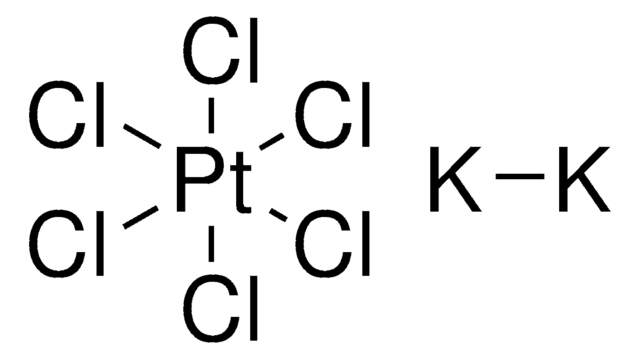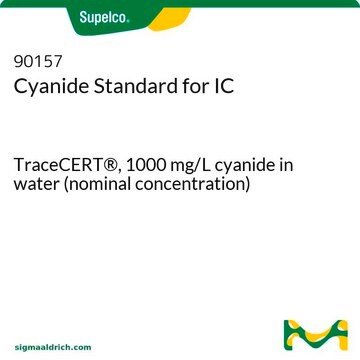379859
Potassium hexachloroplatinate(IV)
≥99.99% trace metals basis
Synonyme(s) :
Dipotassium hexachloroplatinate, Dipotassium platinum hexachloride, Platinic potassium chloride, Platinum potassium chloride, Potassium chloroplatinate, Potassium platinum(IV) chloride, Potassium platinum(IV) hexachloride
About This Item
Produits recommandés
Pureté
≥99.99% trace metals basis
Forme
powder
Impuretés
≤100.0 ppm Trace Metal Analysis
Pf
250 °C (dec.) (lit.)
Chaîne SMILES
[K+].[K+].Cl[Pt--](Cl)(Cl)(Cl)(Cl)Cl
InChI
1S/6ClH.2K.Pt/h6*1H;;;/q;;;;;;2*+1;+4/p-6
Clé InChI
DPAIVKJGTXERIM-UHFFFAOYSA-H
Vous recherchez des produits similaires ? Visite Guide de comparaison des produits
Catégories apparentées
Description générale
Application
Mention d'avertissement
Danger
Mentions de danger
Conseils de prudence
Classification des risques
Acute Tox. 3 Oral - Aquatic Acute 1 - Aquatic Chronic 1 - Eye Dam. 1 - Met. Corr. 1 - Resp. Sens. 1 - Skin Sens. 1 - STOT RE 1
Code de la classe de stockage
6.1B - Non-combustible acute toxic Cat. 1 and 2 / very toxic hazardous materials
Classe de danger pour l'eau (WGK)
WGK 1
Point d'éclair (°F)
does not flash
Point d'éclair (°C)
does not flash
Équipement de protection individuelle
Eyeshields, Faceshields, Gloves, type P2 (EN 143) respirator cartridges
Certificats d'analyse (COA)
Recherchez un Certificats d'analyse (COA) en saisissant le numéro de lot du produit. Les numéros de lot figurent sur l'étiquette du produit après les mots "Lot" ou "Batch".
Déjà en possession de ce produit ?
Retrouvez la documentation relative aux produits que vous avez récemment achetés dans la Bibliothèque de documents.
Les clients ont également consulté
Notre équipe de scientifiques dispose d'une expérience dans tous les secteurs de la recherche, notamment en sciences de la vie, science des matériaux, synthèse chimique, chromatographie, analyse et dans de nombreux autres domaines..
Contacter notre Service technique
















